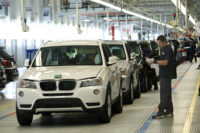MUNICH—The BMW Group is increasingly relying on advanced technology to streamline logistics and material handling in its assembly plants. Tools being deployed on the factory floor include mobile robots and wearable devices.
Employees can monitor and control parts flow from mobile devices such as smartphones and tablet computers. They also use virtual reality applications to plan future logistics. The goal is to ensure that the company’s global production network continues to receive the parts it needs in a timely and reliable manner.
“Logistics is the heart of our production system,” says Jürgen Maidl, head of logistics for the BMW Group production network. “Our broad spectrum of ground-breaking projects helps us run increasingly complex logistics processes efficiently and transparently.
“We are taking advantage of the wide range of available technological innovations and working closely with universities and start-ups,” claims Maidl. “We are already working with tomorrow’s Industry 4.0 technologies today.”
Approximately 1,800 suppliers at more than 4,000 locations worldwide deliver more than 31 million parts to 30 BMW production sites every day. Digitalization and innovations help the company operate the process more flexibly and more efficiently.
BMW engineers rely on a global supply network and close cooperation with numerous logistics service providers. The company’s Connected Supply Chain program emphasizes transparency.
It updates the plants’ material controllers and logistics specialists on the parts’ location and delivery time every 15 minutes. This transparency enables them to respond immediately if delays appear likely and take appropriate steps early to avoid costly extra runs.
Autonomous transport systems, such as tugger trains and mobile robots, are used to move parts and components to assembly lines.
As part of a pilot project, BMW’s plant in Dingolfing, Germany, has developed an automation kit that enables conventional tugger trains of any brand already on hand to be upgraded to autonomous tugger trains. The factory also uses smart watches that automatically announce approaching tugger trains via a vibration alarm. Operators can read which containers should be unloaded and send the tugger on to its next destination by tapping the display.
BMW is pioneering the use of autonomous outdoor transport system at its Leipzig plant. It brings semi-truck trailers from where they are parked to the unloading and loading bay on their own.
“A mobile platform drives underneath the trailer, connects it and steers it through the plant,” explains Maidl. “The AutoTrailer, with a payload of up to 30 tons, navigates by laser, without additional guidelines or markings, through the plant’s outdoor areas. Sensors and cameras provide a 360-degree all-round view.”
BMW employees also are using wearable devices such as data glasses and gloves with integrated scanners and displays.
“The transition to paperless logistics, with digitally labelled containers and shelves, opens up new areas of application for mobile devices,” says Maidl. “Glove scanners read the electronic label and indicate the exact contents of the small load carrier on a small display that can be worn on the arm.
“The use of virtual reality already plays an important role in planning logistics spaces,” adds Maidl. “In a virtual environment, planners can quickly and efficiently lay out future logistics areas completely and assess how much space is needed, for instance.
“[We] have been capturing [our] plants in digital form with millimeter accuracy, using special 3D scanners and high-resolution cameras,” says Maidl. “This creates a three-dimensional image of the structures, so that manual recording on site is no longer needed. When planning future logistics areas, [employees] can now combine existing data with a virtual library of shelves, lattice boxes, small load carriers and other widely-used operating resources.”





